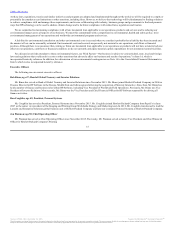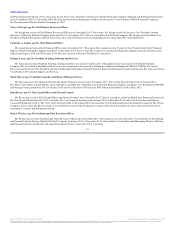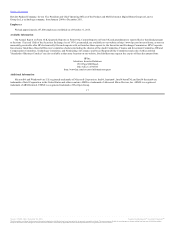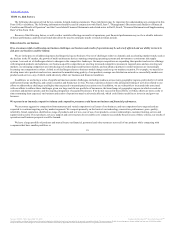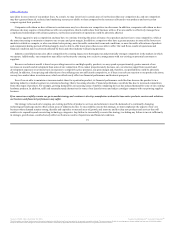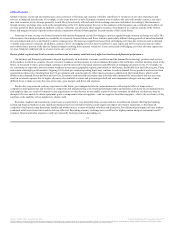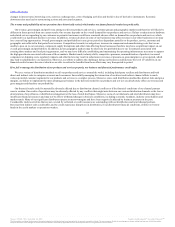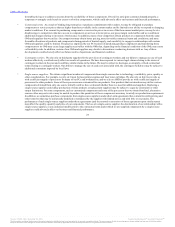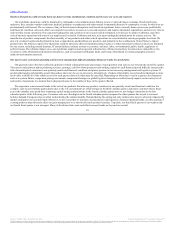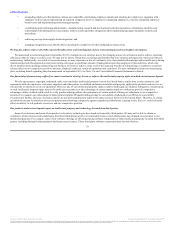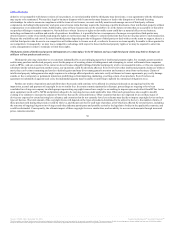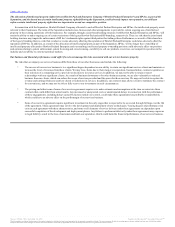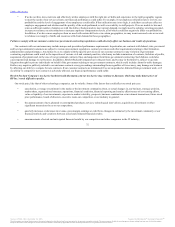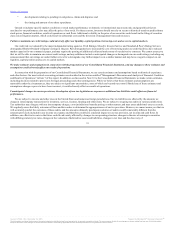HP 2015 Annual Report Download - page 27
Download and view the complete annual report
Please find page 27 of the 2015 HP annual report below. You can navigate through the pages in the report by either clicking on the pages listed below, or by using the keyword search tool below to find specific information within the annual report.
Table of Contents
Business disruptions could seriously harm our future revenue and financial condition and increase our costs and expenses.
Our worldwide operations could be disrupted by earthquakes, telecommunications failures, power or water shortages, tsunamis, floods, hurricanes,
typhoons, fires, extreme weather conditions, medical epidemics or pandemics and other natural or manmade disasters or catastrophic events, for which we are
predominantly self-insured. The occurrence of any of these business disruptions could result in significant losses, seriously harm our revenue, profitability
and financial condition, adversely affect our competitive position, increase our costs and expenses, and require substantial expenditures and recovery time in
order to fully resume operations. Our corporate headquarters and a portion of our research and development activities are located in California, and other
critical business operations and some of our suppliers are located in California and Asia, near major earthquake faults known for seismic activity. The
manufacture of product components, the final assembly of our products and other critical operations are concentrated in certain geographic locations. We
also rely on major logistics hubs primarily in Asia to manufacture and distribute our products, and primarily in the southwestern United States to import
products into the Americas region. Our operations could be adversely affected if manufacturing, logistics or other operations in these locations are disrupted
for any reason, including natural disasters, IT system failures, military actions or economic, business, labor, environmental, public health, regulatory or
political issues. The ultimate impact on us, our significant suppliers and our general infrastructure of being located near locations more vulnerable to the
occurrence of the aforementioned business disruptions, such as near major earthquake faults, and being consolidated in certain geographical areas is
unknown and remains uncertain.
Our uneven sales cycle makes planning and inventory management difficult and future financial results less predictable.
Our quarterly sales often have reflected a pattern in which a disproportionate percentage of each quarter's total sales occurs towards the end of the quarter.
This uneven sales pattern makes predicting revenue, earnings, cash flow from operations and working capital for each financial period difficult, increases the
risk of unanticipated variations in our quarterly results and financial condition and places pressure on our inventory management and logistics systems. If
predicted demand is substantially greater than orders, there may be excess inventory. Alternatively, if orders substantially exceed predicted demand, we may
not be able to fulfill all of the orders received in each quarter and such orders may be cancelled. Depending on when they occur in a quarter, developments
such as a systems failure, component pricing movements, component shortages or global logistics disruptions could adversely impact our inventory levels
and results of operations in a manner that is disproportionate to the number of days in the quarter affected.
We experience some seasonal trends in the sale of our products that also may produce variations in our quarterly results and financial condition. For
example, sales to governments (particularly sales to the U.S. government) are often stronger in the third calendar quarter, and many customers whose fiscal
year is the calendar year spend their remaining capital budget authorizations in the fourth calendar quarter prior to new budget constraints in the first
calendar quarter of the following year. Consumer sales are often higher in the fourth calendar quarter compared to other quarters due in part to seasonal
holiday demand. European sales are often weaker during the summer months. Demand during the spring and early summer also may be adversely impacted by
market anticipation of seasonal trends. Moreover, to the extent that we introduce new products in anticipation of seasonal demand trends, our discounting of
existing products may adversely affect our gross margin prior to or shortly after such product launches. Typically, our third fiscal quarter is our weakest and
our fourth fiscal quarter is our strongest. Many of the factors that create and affect seasonal trends are beyond our control.
25
Source: HP INC, 10-K, December 16, 2015 Powered by Morningstar® Document Research℠
The information contained herein may not be copied, adapted or distributed and is not warranted to be accurate, complete or timely. The user assumes all risks for any damages or losses arising from any use of this information,
except to the extent such damages or losses cannot be limited or excluded by applicable law. Past financial performance is no guarantee of future results.


